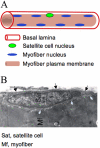The skeletal muscle satellite cell: still young and fascinating at 50
- PMID: 22147605
- PMCID: PMC3283088
- DOI: 10.1369/0022155411426780
The skeletal muscle satellite cell: still young and fascinating at 50
Abstract
The skeletal muscle satellite cell was first described and named based on its anatomic location between the myofiber plasma and basement membranes. In 1961, two independent studies by Alexander Mauro and Bernard Katz provided the first electron microscopic descriptions of satellite cells in frog and rat muscles. These cells were soon detected in other vertebrates and acquired candidacy as the source of myogenic cells needed for myofiber growth and repair throughout life. Cultures of isolated myofibers and, subsequently, transplantation of single myofibers demonstrated that satellite cells were myogenic progenitors. More recently, satellite cells were redefined as myogenic stem cells given their ability to self-renew in addition to producing differentiated progeny. Identification of distinctively expressed molecular markers, in particular Pax7, has facilitated detection of satellite cells using light microscopy. Notwithstanding the remarkable progress made since the discovery of satellite cells, researchers have looked for alternative cells with myogenic capacity that can potentially be used for whole body cell-based therapy of skeletal muscle. Yet, new studies show that inducible ablation of satellite cells in adult muscle impairs myofiber regeneration. Thus, on the 50th anniversary since its discovery, the satellite cell's indispensable role in muscle repair has been reaffirmed.
Conflict of interest statement
The author(s) declared no potential conflicts of interest with respect to the authorship and publication of this article.
Figures





Similar articles
-
Isolation, Culture, and Immunostaining of Skeletal Muscle Myofibers from Wildtype and Nestin-GFP Mice as a Means to Analyze Satellite Cell.Methods Mol Biol. 2017;1556:51-102. doi: 10.1007/978-1-4939-6771-1_4. Methods Mol Biol. 2017. PMID: 28247345
-
Satellite cells: the architects of skeletal muscle.Curr Top Dev Biol. 2014;107:161-81. doi: 10.1016/B978-0-12-416022-4.00006-8. Curr Top Dev Biol. 2014. PMID: 24439806 Review.
-
Single EDL Myofiber Isolation for Analyses of Quiescent and Activated Muscle Stem Cells.Methods Mol Biol. 2018;1686:149-159. doi: 10.1007/978-1-4939-7371-2_11. Methods Mol Biol. 2018. PMID: 29030819
-
Myogenic Satellite Cells: Biological Milieu and Possible Clinical Applications.Pak J Biol Sci. 2017;20(1):1-11. doi: 10.3923/pjbs.2017.1.11. Pak J Biol Sci. 2017. PMID: 29023009 Review.
-
Satellite cells are essential for skeletal muscle regeneration: the cell on the edge returns centre stage.Development. 2012 Aug;139(16):2845-56. doi: 10.1242/dev.069088. Development. 2012. PMID: 22833472 Review.
Cited by
-
Moderate-intensity treadmill running promotes expansion of the satellite cell pool in young and old mice.FEBS J. 2013 Sep;280(17):4063-73. doi: 10.1111/febs.12228. Epub 2013 Apr 12. FEBS J. 2013. PMID: 23464362 Free PMC article.
-
Influence of physical exercise on microRNAs in skeletal muscle regeneration, aging and diseases.Oncotarget. 2018 Mar 30;9(24):17220-17237. doi: 10.18632/oncotarget.24991. eCollection 2018 Mar 30. Oncotarget. 2018. PMID: 29682218 Free PMC article. Review.
-
Edible mycelium as proliferation and differentiation support for anchorage-dependent animal cells in cultivated meat production.NPJ Sci Food. 2024 Apr 30;8(1):23. doi: 10.1038/s41538-024-00263-0. NPJ Sci Food. 2024. PMID: 38693150 Free PMC article.
-
Current Strategies for the Regeneration of Skeletal Muscle Tissue.Int J Mol Sci. 2021 May 31;22(11):5929. doi: 10.3390/ijms22115929. Int J Mol Sci. 2021. PMID: 34072959 Free PMC article. Review.
-
Myokines in Home-Based Functional Electrical Stimulation-Induced Recovery of Skeletal Muscle in Elderly and Permanent Denervation.Eur J Transl Myol. 2018 Nov 16;28(4):7905. doi: 10.4081/ejtm.2018.7905. eCollection 2018 Nov 2. Eur J Transl Myol. 2018. PMID: 30662701 Free PMC article.
References
-
- Aguennouz M, Vita GL, Messina S, Cama A, Lanzano N, Ciranni A, Rodolico C, Di Giorgio RM, Vita G. 2011. Telomere shortening is associated to TRF1 and PARP1 overexpression in Duchenne muscular dystrophy. Neurobiol Aging. 32:2190–2197 - PubMed
-
- Anderson JE. 2006. The satellite cell as a companion in skeletal muscle plasticity: currency, conveyance, clue, connector and colander. J Exp Biol. 209:2276–2292 - PubMed
Publication types
MeSH terms
Substances
Grants and funding
LinkOut - more resources
Full Text Sources
Other Literature Sources

